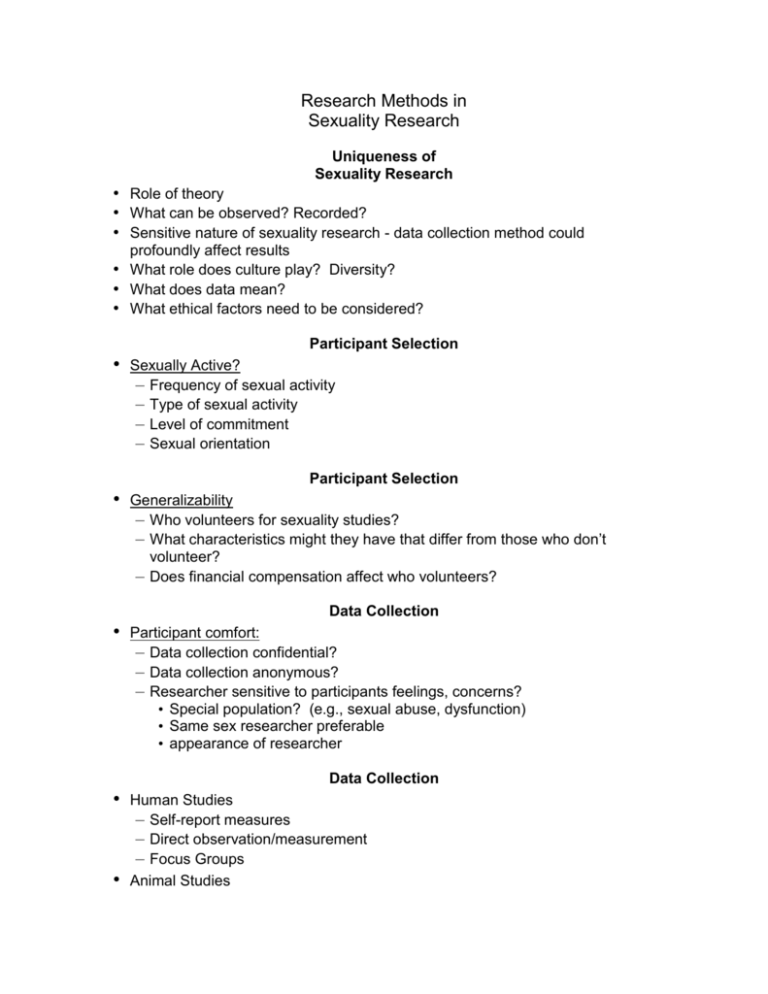
Research Methods in
Sexuality Research
Uniqueness of
Sexuality Research
• Role of theory
• What can be observed? Recorded?
• Sensitive nature of sexuality research - data collection method could
profoundly affect results
• What role does culture play? Diversity?
• What does data mean?
• What ethical factors need to be considered?
Participant Selection
•
Sexually Active?
– Frequency of sexual activity
– Type of sexual activity
– Level of commitment
– Sexual orientation
Participant Selection
•
Generalizability
– Who volunteers for sexuality studies?
– What characteristics might they have that differ from those who don’t
volunteer?
– Does financial compensation affect who volunteers?
Data Collection
•
Participant comfort:
– Data collection confidential?
– Data collection anonymous?
– Researcher sensitive to participants feelings, concerns?
• Special population? (e.g., sexual abuse, dysfunction)
• Same sex researcher preferable
• appearance of researcher
Data Collection
•
•
Human Studies
– Self-report measures
– Direct observation/measurement
– Focus Groups
Animal Studies
•
Data Collection
Self-report measures (survey, interview)
– Is the measure validated?
• On the population you are assessing?
• Is the measure up to date?
– Is the measure reliable?
– Pros:
• Able to assess wide range of sexual issues (e.g., behaviors, beliefs,
fantasies)
• Not invasive
– Cons:
• selection/sampling bias
• self-report bias:
– Purposeful Distortion - Social Desirability: restricted by persons
willingness to self-disclose (e.g., “I have had anal sex.”)
– affected by persons subjective interpretation
(e.g., “I have sexual fantasies at least once a day.” - what constitutes
a sexual fantasy?)
– Accuracy of memory
Ability to estimate
correlational - no cause and effect (correlation b/w depression & low
desire)
–
•
•
Direct observation
– at home or in a laboratory
– participant, laboratory observations, animal research
– observer bias?
–
–
–
–
–
•
Reliability: would we get the same result if we observed it again?
Generalizability: ecological validity
Determining categories: no overlap, all areas covered
Observer role: is the participant or researcher the observer?
Ethical issues
Direct observation: at home
– example:
• daily dairy
• record experiences after sexual activity (e.g., intensity of orgasm)
– pros: more natural, more generalizable, greater ecological validity
– cons: difficult to control variables (e.g., time spent in foreplay)
Diaries:
– structured vs. unstructured
– Pros:
• reduces memory biases: ability to record behavior/feeling immediately
– Cons:
• attrition due to amount of time needed
• failure to complete the diary as instructed (e.g., within time limit)
• Direct Observation: in the laboratory
– two rooms: one for subject, one for experimenter
• privacy
• minimize influence of sounds/noises
• permits training
• standardization of study situation - experimenters behavior could affect
outcome
– stimulus:
• erotica that is designed for male vs. female audience
– auditory? Visual?
– Acceptable sexual behaviors?
– characteristics of erotica (e.g., women with plastic surgery?)
• standardization of erotica
– Pros: able to obtain direct measures of sexual behavior (e.g., sexual
arousal, orgasm)
– Cons: invasive, not generalizable, less ecological validity, subject selection
bias
•
Psychophysiological data: Sexual Arousal
– Men
• air volumetric plethysmograph
• strain gauge
• Rigiscan Plus monitor - penile circumference and rigidity
Rigiscan Plus
Data Collection
– Women:
• vaginal photoplethysmograph
– vaginal pulse amplitude (VPA)
– vaginal blood volume (VBV)
• labial temperature
• changes in oxygen pressure
•
Psychophysiological data: Orgasm
– Men & Women
– latency to orgasm
– measure muscular contractions
•
Focus Groups
– exploratory research (e.g., developing questionnaires)
– to explore areas not amenable to direct observation
– to gain understanding of a group with which there is relatively little
information
• Animal studies
– Pros: able to conduct experiments - manipulate variables
• conduct studies that would be unethical in humans
• conduct studies that would be logistically difficult in humans
• conduct studies that would be expensive in humans
• test hypotheses in animals prior to humans
– Cons: generalizability to humans
• Is the animal physiology similar?
• Is the animal behavior comprable? (e.g., lordosis)
Characteristics of Sex Research Participants
• Are people willing to volunteer for sexuality studies?
Conclusion: more invasive the study, fewer volunteers (Wolchik et al.)
• What is the difference between those who do/do not volunteer for an intrusive
study?
Conclusion: different in sex-related personality (e.g., sex guilt) but not
different in general personality (e.g., extraversion, lying) (Farkas, Sine, &
Evans)
Characteristics of Research Participants
% Volunteered
Men
Women
film
50% 49%
subjective arousal
57% 44%
physiological arousal - forehead 66% 41%
physiological arousal - clothed lap67% 38%
physiological arousal - unclothed 30% 13%
genital gage
26% 13%
(Wolchik)
Interpreting Research Results
•
Sampling Considerations
– Is a significant proportion of the population absent?
– Were the participants selected based on sexual characteristics?
– Did any subjects withdraw from the study? What characteristics might they
have that differ from those who did not withdraw?
– Was there any measurement error such that the true mean and the sample
mean might differ?
•
Threats to interpretation:
– researchers’ beliefs, measurement issues, statistical results (statistical vs
meaningful differences)
– misunderstanding the mean
• the degree to which it applies to individuals (e.g., 28 day menstrual
cycle)
• relative importance of being average (e.g., frequency of sexual activity
vs. sexual compatibility and satisfaction
– poor operational definitions (e.g., measuring attempted vs. completed
sexual assault)
– researchers’ beliefs, measurement issues, statistical results (statistical vs
meaningful differences)
– misunderstanding the mean
• the degree to which it applies to individuals (e.g., 28 day menstrual
cycle)
• relative importance of being average (e.g., frequency of sexual activity
vs. sexual compatibility and satisfaction
– poor operational definitions (e.g., measuring attempted vs. completed
sexual assault)
– researchers’ language (e.g., “Have you had sex when you didn’t want to
because a man gave you alcohol or drugs?” regret vs. rape?)
– consider assumptions (e.g., woman as victims of sexual assault - what
about men?)
•
Interpret results at a societal level








